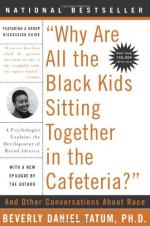
|
| Name: _________________________ | Period: ___________________ |
This test consists of 5 short answer questions, 10 short essay questions, and 1 (of 3) essay topics.
Short Answer Questions
1. In what year did the United States of America annex the Republic of Texas and admit it to the Union as the 28th state?
2. Who signed Executive order 11246?
3. What is the first factor the author describes for why process-oriented affirmative action is often ineffective in Part III, Understanding Whiteness in a White Context, Chapter 7, White Identity and Affirmative Action?
4. In what year did Virginia law state that to be defined as "mulatto," a person had to have at least one-quarter African ancestry?
5. Tatum claims that the idea that biracial children suffer in a particular way during childhood is what in Part IV, Beyond Black and White, Chapter 9, Identity Development in Multiracial Families?
Short Essay Questions
1. How does the author introduce the concept of affirmative action in Part III, Understanding Whiteness in a White Context, Chapter 7, White Identity and Affirmative Action?
2. When and how does Tatum describe the need for racial consciousness in biracial children in Part IV, Beyond Black and White, Chapter 9, Identity Development in Multiracial Families?
3. What misconception does the author attempt to clear away in Part IV, Beyond Black and White, Chapter 9, Identity Development in Multiracial Families?
4. How does the author assert whites learn about racism in Part III, Understanding Whiteness in a White Context, Chapter 6, The Development of White Identity?
5. How does the author suggest we as individuals seek the courage to open racial dialogues in Part V, Breaking the Silence, Chapter 10, Embracing a Cross-Racial Dialogue?
6. How is biracial development approached by the author in Part IV, Beyond Black and White, Chapter 9, Identity Development in Multiracial Families?
7. What do productive racial dialogues promote, according to the author in Part V, Breaking the Silence, Chapter 10, Embracing a Cross-Racial Dialogue?
8. How does Tatum describe the variations and similarities within the Latino community in Part IV, Beyond Black and White, Chapter 8, Critical Issues in Latino, American Indian, and Asian Pacific American Identity Development?
9. How does the author describe differences between males and females in biracial identity formation in Part IV, Beyond Black and White, Chapter 9, Identity Development in Multiracial Families?
10. What are the costs of a lack of a racial dialogue, according to the author in Part V, Breaking the Silence, Chapter 10, Embracing a Cross-Racial Dialogue?
Essay Topics
Write an essay for ONE of the following topics:
Essay Topic 1
Discuss the differences and similarities between the dominant and subordinate groups described in the author's experimentation in Part I, A Definition of Terms, Chapter 2, The Complexity of Identity. How might the responses change at different ages?
Essay Topic 2
Discuss child development and racial identity. At what age does the author assert children first recognize race?
Essay Topic 3
Describe and discuss Erik Erikson and his model for identity development. What stages are delineated in Erikson's model?
|
This section contains 963 words (approx. 4 pages at 300 words per page) |

|




